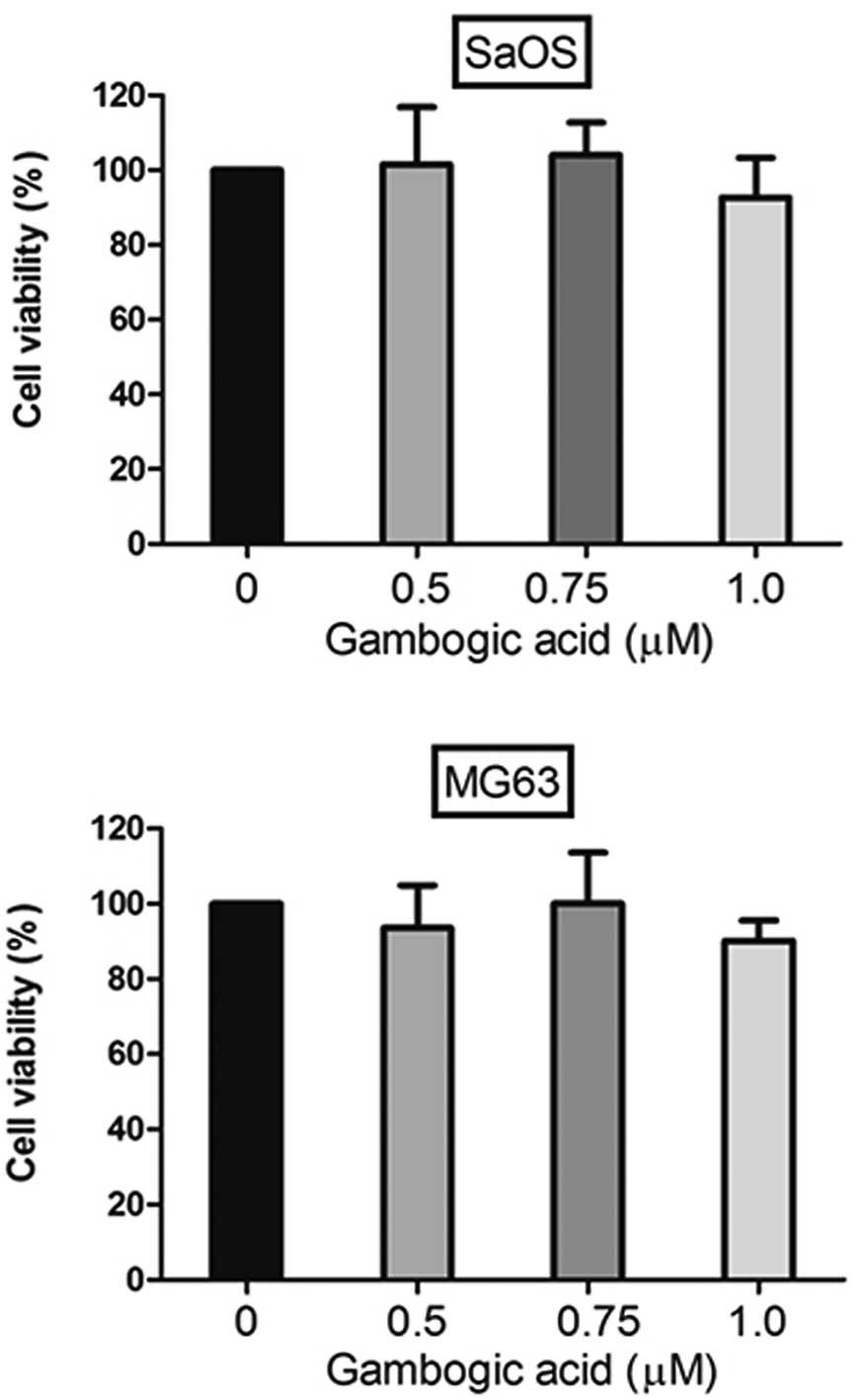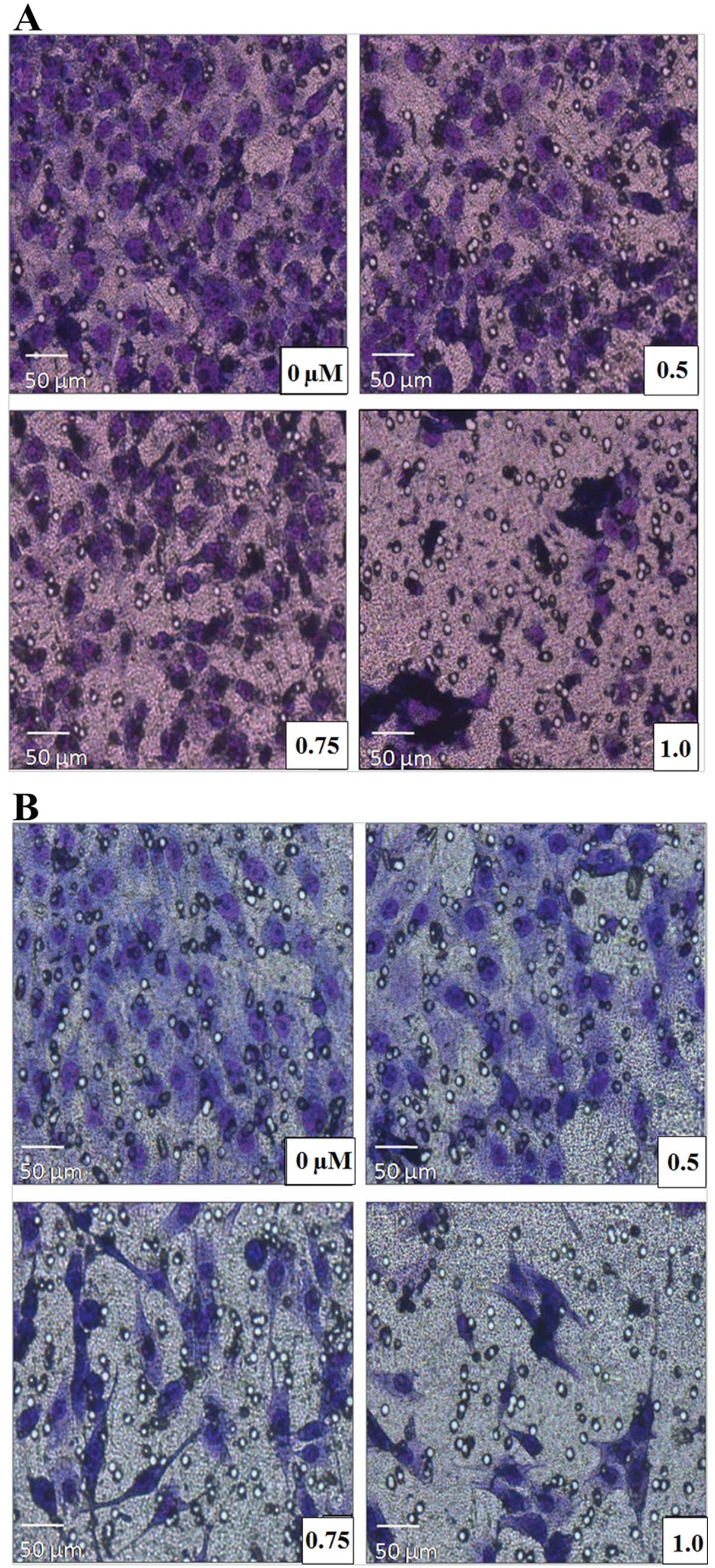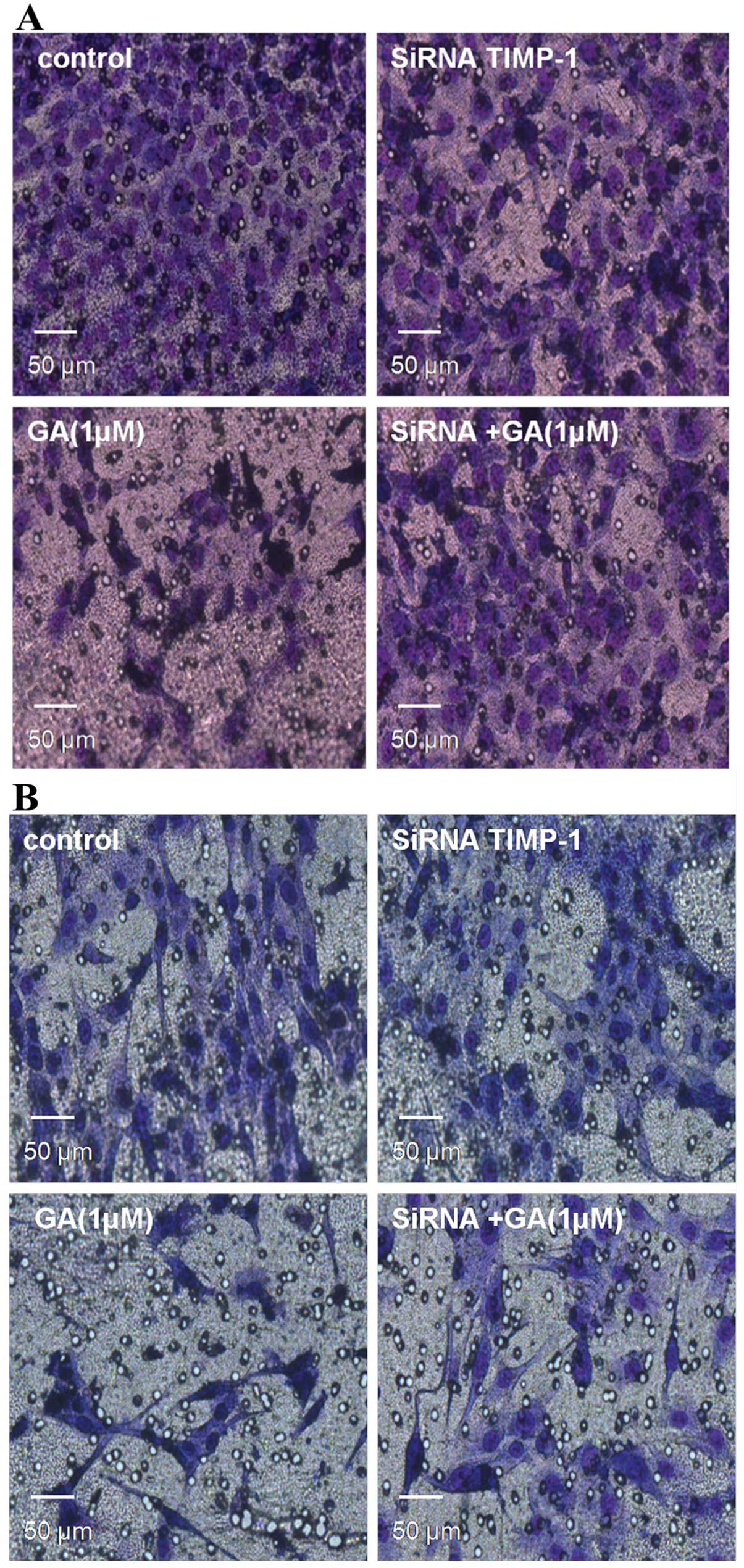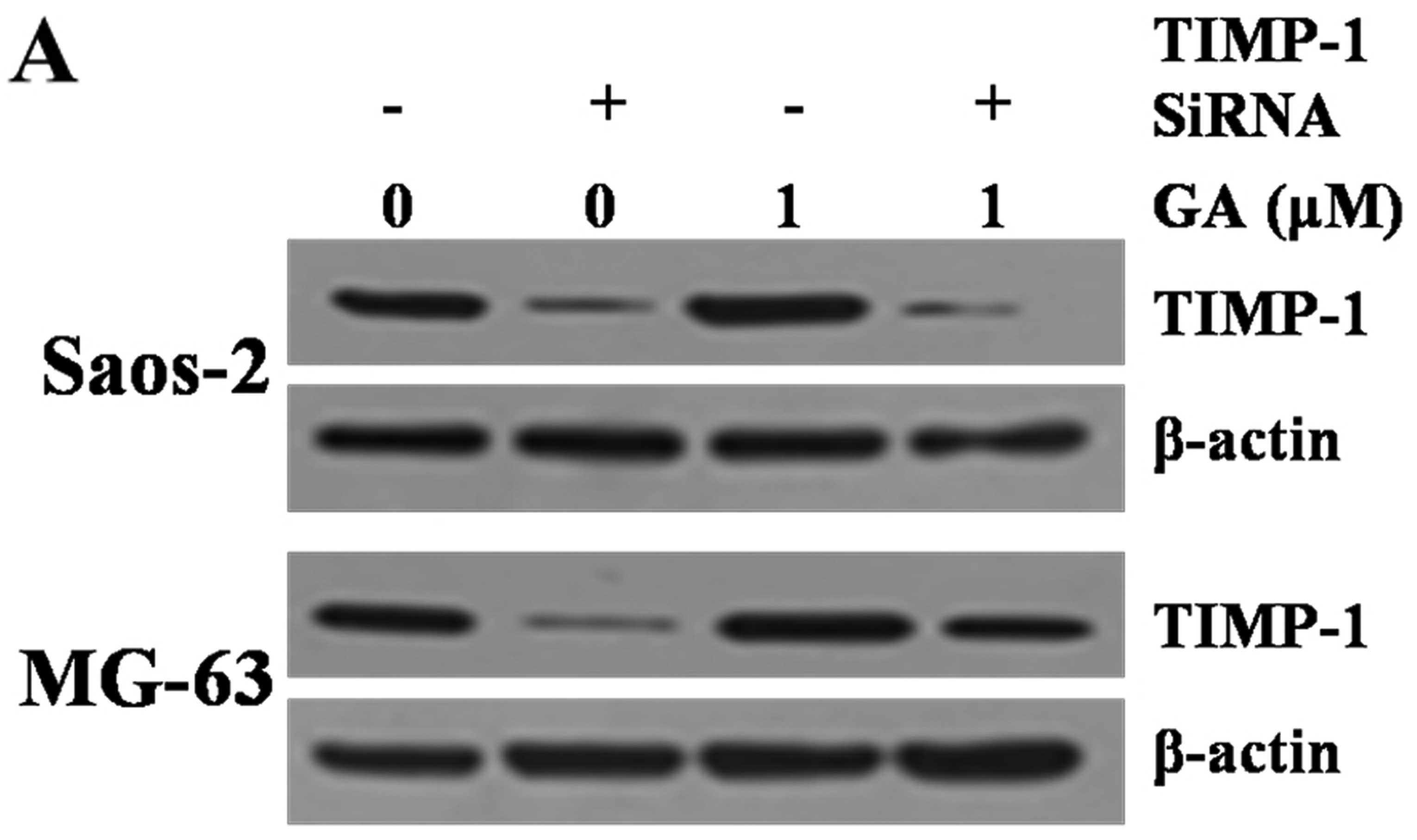Gambogic acid inhibits invasion of osteosarcoma via upregulation of TIMP-1
- Authors:
- Published online on: November 21, 2012 https://doi.org/10.3892/ijmm.2012.1192
- Pages: 105-112
Abstract
Introduction
Osteosarcoma (OS) is one of the most common malignant, aggressive tumors of bone in children and adolescents which requires a combined approach of surgery and systemic chemotherapy (1). The prognosis has improved markedly due to the introduction of aggressive chemotherapy into the multi-modal treatment regimen of OS. However, 30–50% of these patients with initially localized disease subsequently develop recurrence, which has an extremely poor clinical outcome, and 20% of all OS patients succumb to the disease due to tumor metastasis (2–5). As a consequence, new therapeutic strategies need to be actively explored to increase the survival rate of patients with OS.
The processes of tumor growth, invasion, and metastasis refer to tumor cell proliferation, cell migration and penetration through the extracellular matrix (ECM) (6). The balance in the activity between matrix matalloproteinases (MMPs) and tissue inhibitors of metalloproteinases (TIMPs) is responsible for the proper maintenance of tissue. Disruption of this balance influences the metastasis and invasion of cancer and is associated with survival and prognosis (7,8).
MMPs are a family of zinc-dependent endopeptidases which have been shown to play a major role in ECM remodeling. MMPs comprise more than 25 members which are classified based on their substrate specificities and structural characteristics (9,10). In particular, the 92-kDa gelatinase B/Type IV (MMP-9) is one of the well-studied members of the MMP family, which is significantly involved in tumor invasion and angiogenesis. The ECM and basement membrane turnover is regulated by a delicate balance between the molecular factors that are involved in the production, activation, and inhibition MMPs and the production of natural TIMPs (11,12). Four members of the TIMP family have been identified (TIMP1–4) (13). TIMPs suppress MMP activity critical for ECM turnover associated with both physiological and pathological tissue remodeling. TIMP-1 is a multifunctional protein which specifically interacts with pro-MMP-9 and is subject to tight control at the level of transcription (14), whereas it has been shown that the elevated expression of TIMP-1 closely correlates with a more aggressive clinical behavior and poor prognosis in human cancer specimens (15–17). These findings suggest that TIMP-1 plays dual roles in cancer progression. Previous reports have indicated that MMP-9 and TIMP-1 are involved in the OS progression, and they have been shown to be associated with poor prognosis in human OS (18,19).
Gambogic acid (GA) (C38H44O8), a natural compound extracted from gamboges, has recently been identified as a potent anticancer agent. Zhao et al (20) reported that GA can induce apoptosis and cell cycle arrest of OS cell lines. In recent years, studies have shown that GA can equally inhibit the growth of a variety of tumor cells, including hepatoma, gastric and breast cancer (21–25). Moreover, it was also reported that GA exhibits low toxicity against normal tissues (26,27). The aim of our study was to examine the levels of MMP-9 and TIMP-1 in GA-treated OS cells in order to further investigate the anti-OS effect of GA.
Materials and methods
Reagents
GA was purchased from Sigma-Aldrich (St. Louis, MO, USA) with a purity of >95%. It was dissolved in dimethyl sulfoxide (DMSO) (Sigma-Aldrich) and stored at −20°C at a concentration of 10 mmol/l; the final concentration of DMSO was <0.1%. The cell counting kit-8 (CCK-8) was purchased from Dojindo Laboratories (Japan). The primary antibodies against MMP-9, TIMP-1, GAPDH and secondary antibodies were purchased from Santa Cruz Biotechnology, Inc. (Santa Cruz, CA, USA).
Saos-2 and MG-63 cell culture
The established human OS cell lines MG-63 (CRL-1427TM, ATCC) and Saos-2 (HTB-85TM, ATCC) were obtained from the Cell Bank of Shanghai Institute of Biochemistry and Cell Biology, Chinese Academy of Sciences (Shanghai, China), where they were tested and authenticated. MG-63 and Saos-2 cells were cultured in a humid atmosphere of 5% CO2 and 95% air at 37°C in Dulbecco’s modified Eagle’s medium (DMEM) or McCoy’s 5A Medium supplemented with 10% heat-inactivated fetal bovine serum (all were from Gibco-Life Sciences, USA). The medium was changed every 2–3 days, and cells were passaged twice a week. All experiments described were performed at least six times using cells at the exponential growth phase.
Effect of GA on cell proliferation by the cell counting kit-8 (CCK-8) assay
Saos-2 and MG-63 cells were seeded onto a 96-well culture plate at a density of 0.8–1×104 cells/well. On the second day of culture, media were replaced with 100 μl of serum-free medium and GA at concentrations of 0–1 μM. On the third day, 10 μl of CCK-8 were added to each well and incubated for 1 h. The absorbance (A) was measured at 450 nm by a Microplate reader (Bio-Rad 550; Bio-Rad, USA). The percentage of cell viability was calculated as follows: cell viability (%) = A of experimental well/A of control well ×100%. The IC50 was the concentration of GA that caused 50% inhibition of cell viability.
Matrigel invasion assay
Invasion assay was performed using a transwell chamber (Neuro Probe, Inc., USA) and 8-μm pore size polycarbonate membranes (Costar, Cambridge, MA, USA) coated with Matrigel. Saos-2 and MG-63 cells were seeded at a density of 4×104 in 350 μl of serum free-MEM in the upper compartment of the transwell. Complete MEM was placed in the lower chamber. Following overnight incubation at 37°C, the medium in the upper chamber was replaced with serum-free MEM and cells were treated with GA at 0, 0.5, 0.75 and 1 μM for 48 h of incubation at 37°C in a 5% CO2 atmosphere. Non-invaded cells were wiped gently with the Matrigel. Finally, the invaded cells on the surface of the membranes were fixed and stained using Hemacolor® (Merck Millipore, Darmstadt, Germany). The number of invaded cells in six randomly selected microscopic fields (×200 magnifications) per membrane was counted.
Western blot analysis
Cells were treated with GA (0, 0.5, 0.75 and 1 μM) for 48 h, scraped into 1× cell lysis buffer (Cell Signaling Technology, USA), and incubated for 10 min on ice. Debris from the lysed cells was pelleted by centrifugation at 6,700 × g at 4°C for 5 min. The protein concentration of each sample was assayed using the bicinchoninic acid method (BCA kit) (Pierce, Rockford, IL, USA). Cell lysates, containing same amounts of protein, were mixed with equal volumes of 4× sample loading buffer, boiled for 5 min, cooled on ice for 5 min, and then analyzed by 10% Tris-HCl SDS polyacrylamide gel electrophoresis (SDS-PAGE). Protein was electrotransferred to a polyvinylidene difluoride membrane, and then blocked with 5% nonfat dry milk in 20 mM of TBS with 0.1% Tween-20 for 1 h at room temperature with shaking and incubated with the indicated primary antibodies followed by HRP-conjugated secondary antibody. After washing three times, bands were detected using ECL western blotting detection reagents (Santa Cruz Biotechnology, Inc.) and were then imaged with LAS-3000 (Life Science-Fujifilm Global).
Reverse transcription-polymerase chain reaction (RT-PCR)
Cells were treated with GA (0, 0.5, 0.75 and 1 μM) for 48 h and washed twice with ice-cold 1× phosphate-buffered saline (PBS). Total RNA was extracted using TRIzol Reagent (Invitrogen, Carlsbad, CA, USA), according to the manufacturer’s instructions. RNA (1 μg) was reverse-transcribed using the Superscript™ First-Strand Synthesis System for RT-PCR (Invitrogen) at 37°C. The following primers were used to determine target gene levels. β-actin, sense, 5′-CTGGAGCATGCC CGTATTTA-3′ and antisense, 5′-TTTGGTCTTGCCACTTT TCC-3′; MMP-9, sense, 5′-AAGTGGCACCACCACAACAT-3′ and antisense, 5′-TTTCCCATCAGCATTGCCGT-3′; and TIMP-1, sense, 5′-TTCCGACCTCGTCATCAGGG-3′ and antisense, 5′-ATTCAGGCTATCTGGGACCGC-3′. All primers were checked against the GenBank Database to ensure no cross-reactivity with other known human DNA sequences. PCR cycles were performed using the following sequence: 94°C for 5 min, then 30 cycles of denaturation at 94°C for 1 min, annealing at 58°C (for MMP-9) or 60°C (for TIMP-1) for 1 min, and polymerization at 72°C for 1 min, followed by 72°C for 7 min. RT-PCR products were visualized on 1.2% agarose gels electrophoresed in 0.5 TAE buffer containing 0.5 μg/ml ethidium bromide.
siRNA knockdown of TIMP-1
siRNA knockdown was used to inhibit mammalian TIMP-1. Cells were transfected with a pre-designed siRNA (100 nM) against TIMP-1 (sc-29505) using the siRNA Transfection Reagent (sc-29528). The transfection efficiency was >80% (transfection efficiency was assessed visually using control siRNA (fluorescein conjugates) (sc-36869) (all were from Santa Cruz Biotechnology, Inc.) and the extent of TIMP-1 knockdown was determined by western blot analysis of protein levels.
Statistical analysis
Intensity of bands was quantified using SPSS 17.0 software. Results are expressed as the means ± standard deviation. We performed Student’s t-test statistical analysis. P<0.05 was considered to indicate statistically significant differences. Asterisks indicate the level of significance.
Results
Growth inhibition of OS cell lines by GA
We examined the role of GA on proliferation using a CCK-8 assay after treating both cell lines with GA. Saos-2 and MG-63 cells (0.8–1×104 cell/well) were plated in each well of a 96-well plate. Control and 0.5, 0.75 and 1 μM GA-treated Saos-2 and MG-63 cells were incubated for 48 h. CCK-8 assay was performed 2 days after the treatment in order to quantify the proliferation of cells. GA treatment at 0–1 μM for 48 h did not significantly inhibit the growth of either cell line, therefore, there was no significant effect of GA on Saos-2 or MG-63 survival even at the concentration of 1 μM. We performed all subsequent experiments using GA concentrations ranging from 0 to 1 μM (Fig. 1).
GA suppresses the invasive ability of Saos-2 and MG-63 cells
We carried out Matrigel invasion assays to ascertain whether GA affects the invasive behavior of Saos-2 and MG-63 cells. We treated both cell lines with either control or GA (0.5, 0.75 and 1 μM). After 48 h of incubation, we removed transwells and stained invaded cells with Hemacolor® (Merck Millipore) and removed the non-invaded cells. The number of invaded Saos-2 and MG-63 cells treated by GA was significantly reduced, compared to the control, in a dose-dependent manner, indicating that GA inhibited the basal invasion capacity of Saos-2 and MG-63 cells (P<0.05) (Fig. 2).
GA suppresses MMP-9 and enhances TIMP-1 protein and mRNA levels in both cells
To elucidate the mechanism of invasive suppression of Saos-2 and MG-63 cells, we investigated the effect of GA on MMP-9 and TIMP-1 protein expression, which are key effectors for tissue invasion. The expression of TIMP was evaluated since the expression of TIMP suppresses the effect of MMP-9. Saos-2 and MG-63 cells were treated with GA and MMP-9 and TIMP-1 protein levels were observed by western blotting. Western blotting revealed that GA attenuated MMP-9 and increased TIMP-1 protein levels of both cell lines (P<0.05) (Fig. 3). RT-PCR was used to investigate the effects of GA on MMP-9 and TIMP-1 at the transcriptional levels. GA was found to clearly attenuate MMP-9 mRNA levels and the mRNA transcripts of TIMP-1 in both Saos-2 and MG-63 cell lines (P<0.05) (Fig. 4).
Knockdown of TIMP-1 restrains the invasion ability of GA in both cell types
We carried out Matrigel invasion assays again to examine whether TIMP-1 affects the invasive behavior of Saos-2 and MG-63 cells. After transfection with siRNA TIMP-1 for 24 h, we treated both cell lines with either control or GA (1 μM). After 48 h of incubation, we removed transwells and stained invaded cells with Hemacolor® (Merck Millipore) and removed the non-invaded cells. The number of invaded Saos-2 and MG-63 cells treated by GA and siRNA TIMP-1 was significantly increased compared to the cells treated by siRNA TIMP-1 alone, demonstrating that TIMP-1 plays an important role in GA inhibiting the basal invasion capacity of Saos-2 and MG-63 cells (P<0.05) (Fig. 5).
GA specifically enhances TIMP-1 protein and mRNA levels in both cells
To further elucidate the mechanism of invasive suppression of Saos-2 and MG-63 cells, we investigated the effect of GA on TIMP-1 protein expression after transfection with siRNA TIMP-1, which are key effectors for tissue invasion. Saos-2 and MG-63 cells were treated with GA and/or siRNA TIMP-1. TIMP-1 protein levels were observed by western blotting. Western blotting and RT-PCR revealed that GA increased only slightly the TIMP-1 protein and mRNA levels of both cell lines treated by siRNA TIMP-1 (P>0.05) (Fig. 6). However, upregulation of TIMP-1 was significant in siRNA TIMP-1 and GA treated cell lines compared to siRNA TIMP-1 treated cell lines (P>0.05).
Discussion
Tumor metastasis involves a series of mechanisms including vessel formation, cell attachment, invasion, migration and cell proliferation, whose regulation is complex. Numerous in vitro studies have demonstrated that GA exerts its antitumor effects by impeding tumor cell proliferation, inhibiting invasion, inducing tumor cell apoptosis and suppressing MMPs (20,28). In addition, Matrigel is used for in vitro invasion assays. It contains a number of proteins such as laminin, collagen IV, heparan sulfate proteoglycan, entactin, nidogen and growth factors (e.g. TGF-β, fibroblast growth factor, tissue plasminogen activator). It has been used as a model in quantitative analysis. In the present study, we investigated the anti-metastatic effect of GA on the invasion and migration of human OS cell lines using Matrigel migration assay. We found that GA inhibited the in vitro migration and invasion ability of both cell lines (Fig. 2). Our results support the potential use of GA as a new strategy for anticancer therapy against migration and invasion of both cell lines.
Furthermore, it is well known that MMPs and TIMPs play key roles in tumor invasion and metastasis; as a result, the prognostic risk factors of recent studies in OS are focusing on the MMPs and TIMPs. Overall, studies on MMPs and TIMPs in cancer provide the rationale for developing anticancer drugs which target TIMP and MMP activities. TIMP-1 was described to specifically regulate proMMP-9 activation (15). Zhang et al (29) demonstrated that tumor invasion and metastasis were more frequent in patients with tumors which secreted MMP-9 positively whereas they were significantly reduced if TIMP-1 was also expressed; thus, MMP-9 mainly functions to accelerate cancer invasion and metastasis, but TIMP-1 independently exerts an inhibitory function on cancer invasion and metastasis. However, Seo et al (30) suggested that the expression of TIMP-1, as well as the balance between the expression of MMP-9 and TIMP-1, indicates the progressed state of the tumor. It has recently been reported that MMP-2 and MMP-9 are present in human OS cells (31,32). In this study, GA inhibited MMP-9 expression and enhanced TIMP-1 at the protein levels; on the other hand, the mRNA expression of MMP-9 and TIMP-1 was also suppressed by GA.
As we described above, the results of the experiments of molecular biology were based on the assumption of survival rate of the cells greater than 80%. As a consequence, the effect of GA on OS cell invasion is probably not due to cell death. In terms of variation of MMP-9, TIMP-1 and previous theories, we concluded that GA promotes the expression of TIMP-1, probably further repressing the expression of MMP-9. Therefore, the balance between MMP-9 and TIMP-1 may be one of the mechanisms which lead to the inhibition of the OS cell invasion by GA. Of note, in this study, the pharmaceutical effect of GA was reduced when the expression of TIMP-1 was restrained by siRNA. This result revealed that TIMP-1 plays an important role in the reduction of the invasive potential of the OS cells which were treated by GA. The specific pathway of GA-induced TIMP-1 and MMP-9 expression requires further study to be elucidated.
In conclusion, our findings suggest that GA affects the expression and balance of MMP-9 and TIMP-1 in OS, and that this is responsible for its effect on OS cell invasiveness. This report provides the first evidence that GA interferes with the expression and balance of MMP-9 and TIMP-1 in OS cells in vitro. Furthermore, TIMP-1 plays an important role in the reduction of the invasive potential of the OS cells which were treated by GA. Although the precise molecular mechanism of cancer invasiveness and related targeted chemotherapy requires further clarification, these data indicate that GA may be a potential candidate for targeted drug therapy preventing recurrence and metastasis.
Acknowledgements
This study was supported by a grant (N20100757) from the Department of Health of Zhejiang Province.
Abbreviations:
|
GA |
gambogic acid |
|
MMPs |
matrix metalloproteinases |
|
OS |
osteosarcoma |
|
TIMPs |
tissue inhibitors of matrix metalloproteinases |
|
RT-PCR |
reverse transcription-polymerase chain reaction |
References
|
Bacci G, Longhi A, Fagioli F, Briccoli A, Versari M and Picci P: Adjuvant and neoadjuvant chemotherapy for osteosarcoma of the extremities: 27 year experience at Rizzoli Institute, Italy. Eur J Cancer. 41:2836–2845. 2005.PubMed/NCBI | |
|
Bielack SS, Kempf-Bielack B, Delling G, Exner GU and Flege S: Prognostic factors in high-grade osteosarcoma of the extremities or trunk: an analysis of 1,702 patients treated on neoadjuvant cooperative osteosarcoma study group protocols. J Clin Oncol. 20:776–790. 2002. View Article : Google Scholar | |
|
Ferrari S, Briccoli A, Mercuri M, Bertoni F and Picci P: Postrelapse survival in osteosarcoma of the extremities: prognostic factors for long-term survival. J Clin Oncol. 21:710–715. 2003. View Article : Google Scholar : PubMed/NCBI | |
|
Hauben EI, Arends J, Vandenbroucke JP, van Asperen CJ, van Marck E and Hogendoorn PC: Multiple primary malignancies in osteosarcoma patients. Incidence and predictive value of osteosarcoma subtype for cancer syndromes related with osteosarcoma. Eur J Human Genetics. 11:611–618. 2003. View Article : Google Scholar : PubMed/NCBI | |
|
Link MP: Preoperative and adjuvant chemotherapy in osteosarcoma. Frontiers of Osteosarcoma Research: Interdisciplinary Survey of Clinical and Research Advances. Novak JF and Mcmaster JH: Hogrefe and Huber; Seattle: pp. 41–49. 1993 | |
|
Wolf K and Friedl P: Mapping proteolytic cancer cell-extracellular matrix interfaces. Clin Exp Metastasis. 26:289–298. 2009. View Article : Google Scholar : PubMed/NCBI | |
|
Clark IM, Swingler TE, Sampieri CL and Edwards DR: The regulation of matrix metalloproteinases and their inhibitors. Int J Biochem Cell Biol. 40:1362–1378. 2008. View Article : Google Scholar : PubMed/NCBI | |
|
Visse R and Nagase H: Matrix metalloproteinases and tissue inhibitors of metalloproteinases: structure, function, and biochemistry. Circ Res. 92:827–839. 2003. View Article : Google Scholar : PubMed/NCBI | |
|
Brinckerhoff CE and Matrisian LM: Matrix metalloproteinases: a tail of a frog that became a prince. Nat Rev Mol Cell Biol. 3:207–214. 2002. View Article : Google Scholar : PubMed/NCBI | |
|
Egeblad M and Werb Z: New functions for the matrix metalloproteinases in cancer progression. Nat Rev Cancer. 2:161–174. 2002. View Article : Google Scholar : PubMed/NCBI | |
|
Chambers AF and Matrisian LM: Changing views of the role of matrix metalloproteinases in metastasis. J Natl Cancer Inst. 89:1260–1270. 1997. View Article : Google Scholar : PubMed/NCBI | |
|
Hidalgo M and Eckhardt SG: Development of matrix metalloproteinase inhibitors in cancer therapy. J Natl Cancer Inst. 93:178–193. 2001. View Article : Google Scholar : PubMed/NCBI | |
|
Denhardt DT, Feng B, Edwards DR, Cocuzzi ET and Malyankar UM: Tissue inhibitor of metalloproteinases (TIMP, aka EPA): structure, control of expression and biological functions. Pharmacol Ther. 59:329–341. 1993. View Article : Google Scholar : PubMed/NCBI | |
|
Phillips BW, Sharma R, Leco PA and Edwards DR: A sequence-selective single-strand DNA-binding protein regulates basal transcription of the murine tissue inhibitor of metalloproteinases-1 (Timp-1) gene. J Biol Chem. 274:22197–22207. 1999. View Article : Google Scholar | |
|
Kossakowska AE, Urbanski SJ and Edwards DR: Tissue inhibitor of metalloproteinases-1 (TIMP-1) RNA is expressed at elevated levels in malignant non-Hodgkin’s lymphomas. Blood. 77:2475–2481. 1991. | |
|
Yoshiji H, Gomez DE and Thorgeirsson UP: Enhanced RNA expression of tissue inhibitor of metalloproteinases-1 (TIMP-1) in human breast cancer. Int J Cancer. 69:131–134. 1996. View Article : Google Scholar : PubMed/NCBI | |
|
Fong KM, Kida Y, Zimmerman PV and Smith PJ: TIMP1 and adverse prognosis in non-small cell lung cancer. Clin Cancer Res. 2:1369–1372. 1996.PubMed/NCBI | |
|
Bjørnland K, Flatmark K, Pettersen S, Aaasen AO, Fodstad O and Maelandsmo GM: Matrix metalloproteinases participate in osteosarcoma invasion. J Surg Res. 127:151–156. 2005.PubMed/NCBI | |
|
Korpi JT, Hagström J, Lehtonen N, et al: Expression of matrix metalloproteinases-2, -8, -13, -26, and tissue inhibitors of metalloproteinase-1 in human osteosarcoma. Surg Oncol. 20:e18–e22. 2011. View Article : Google Scholar : PubMed/NCBI | |
|
Zhao W, Zhou SF, Zhang ZP, Xu GP, Li XB and Yan JL: Gambogic acid inhibits the growth of osteosarcoma cells in vitro by inducing apoptosis and cell cycle arrest. Oncol Rep. 25:1289–1295. 2011. | |
|
Guo QL, You QD, Wu ZQ, Yuan ST and Zhao L: General gambogic acids inhibited growth of human hepatoma SMMC-7721 cells in vitro and in nude mice. Acta Pharmacol Sin. 25:769–774. 2004.PubMed/NCBI | |
|
Yu J, Guo QL, You QD, et al: Gambogic acid-induced G(2)/M phase cell-cycle arrest via disturbing CDK7-mediated phosphorylation of CDC2/p34 in human gastric carcinoma BGC-823 cells. Carcinogenesis. 28:632–638. 2007. View Article : Google Scholar : PubMed/NCBI | |
|
Kasibhatla S, Jessen KA, Maliartchouk S, et al: A role for transferrin receptor in triggering apoptosis when targeted with gambogic acid. Proc Natl Acad Sci USA. 102:12095–12100. 2005. View Article : Google Scholar : PubMed/NCBI | |
|
Chen J, Gu HY, Lu N, et al: Microtubule depolymerization and phosphorylation of c-Jun n-terminal kinase-1 and p38 were involved in gambogic acid induced cell cycle arrest and apoptosis in human breast carcinoma McF-7 cells. Life Sci. 83:103–109. 2008. View Article : Google Scholar : PubMed/NCBI | |
|
Wu ZQ, Guo QL, You QD, Zhao L and Gu HY: Gambogic acid inhibits proliferation of human lung carcinoma SPC-A1 cells in vivo and in vitro and represses telomerase activity and telomerase reverse transcriptase mRNA expression in the cells. Biol Pharm Bull. 27:1769–1774. 2004. View Article : Google Scholar : PubMed/NCBI | |
|
Guo Q, Qi Q, You Q, Gu H, Zhao L and Wu Z: Toxicological studies of gambogic acid and its potential targets in experimental animals. Basic Clin Pharmacol Toxicol. 99:178–184. 2006. View Article : Google Scholar : PubMed/NCBI | |
|
Qi Q, You Q, Gu H, et al: Studies on the toxicity of gambogic acid in rats. J Ethnopharmacol. 117:433–438. 2008. View Article : Google Scholar : PubMed/NCBI | |
|
Qi Q, Lu N, Wang XT, et al: Anti-invasive effect of gambogic acid in MDA-MB-231 human breast carcinoma cells. Biochem Cell Biol. 86:386–395. 2008. View Article : Google Scholar : PubMed/NCBI | |
|
Zhang S, Li L, Lin JY and Lin H: Imbalance between expression of matrix metalloproteinase-9 and tissue inhibitor of metalloproteinase-1 in invasiveness and metastasis of human gastric carcinoma. World J Gastroenterol. 9:899–904. 2003.PubMed/NCBI | |
|
Seo YS, Park JJ, Kim JH, et al: Usefulness of MMP-9/TIMP-1 in predicting tumor recurrence in patients undergoing curative surgical resection for gastric carcinoma. Dig Dis Sci. 52:753–759. 2007. View Article : Google Scholar : PubMed/NCBI | |
|
Guruvayoorappan C and Kuttan G: Amentoflavone inhibits experimental tumor metastasis through a regulatory mechanism involving MMP-2, MMP-9, prolyl hydroxylase, lysyl oxidase, VEGF, ERK-1, ERK-2, STAT-1, NM23 and cytokines in lung tissues of C57BL/6 mice. Immunopharmacol Immunotoxicol. 30:711–727. 2008. View Article : Google Scholar | |
|
Waas ET, Wobbes T, Lomme RM, DeGroot J, Ruers T and Hendriks T: Matrix metalloproteinase 2 and 9 activity in patients with colorectal cancer liver metastasis. Br J Surg. 90:1556–1564. 2003. View Article : Google Scholar : PubMed/NCBI |















